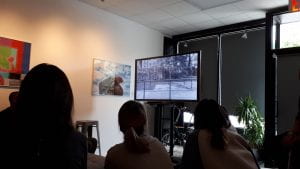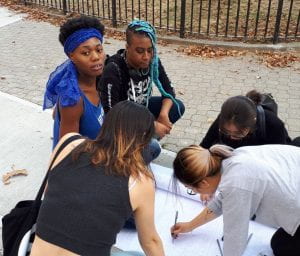On Monday we had our second workshop at Made In Brownsville to kick-start the next phase of our studio project based on modeling the Brownsville neighborhood through film, drawing or physical model making. The goal of the project is to use the various forms of modeling to present, define and show the diverse realities of the site and construct an attitude for the final project. It will also aim to suggest programs and intervention strategies to reoccupy the housing project territory.

The workshop began with a lecture by Ifoema Ebo (AAP B.Arch Alumni) based on the themes of social impact design. Her lecture began with addressing the fundamental problems of public housing; the way public housing is structured is related to the way that institutional racism and white supremacy become a spatial practice. These ideologies then influence the social infrastructure around public housing use in the form of Redlining, poor maintenance, lack of spaces for recreation etc. Instead, the goal should be to inspire justice by design and promote the idea of liberation in spatial practice. It imagines a possible future in which collaborative ideation is possible and black people are cultural and economic innovators. If the social infrastructure is strong, neighborhoods will grow and flourish.
Ebo then shared some of the projects she had worked on, and discussed how might we activate the neighborhood by creating safe spaces for the residents. The process involved mapping out the positive and negative social activities occurring in the community as well as an in-depth analysis of the issues in a community that connects to crime. Once the problems are identified, design solutions can be used to convene and connect people in these spaces. Design solutions can take the form of expanding activity on public property, enabling social connections, or co-locating community organizations and service providers.
After the lecture, for the next half of the workshop we were split into three teams, film, drawing or physical model making in which we were tasked to study the characteristics of the neighborhood, and then use design to activate the site by disrupting or complementing the existing order. When coming up with the ideas, each of the teams had to follow the principles of the BlackSpace Manifesto as well as incorporate ideas of scale and space. We begin by taking a quick tour of the site, studying the surroundings which included streets, buildings, community centers, the urban culture etc. After which, each team brainstormed and presented on ideas or strategies to redefine, reuse, or reoccupy the existing Brownsville housing community.

The film team were focused on the principle of “reckon with the past to build the future” as a way of creating spaces of play and imagination at the scale of a community or neighborhood. They were focused on narrating the monotony of the horizontal asphalt surfaces that characterize the neighborhood, and envisioning how we might transform these spaces for active use.

The drawing team focused on the principle of “celebrate, catalyze and amplify black joy” to create spaces of liberation at the scale of a community. They aimed at creating transparency that would foster trust and honesty. Creating such spaces, involve improving connections to the neighborhood as a whole, creating lighting and seating, introducing programmatic elements as well as information booths for people in the community to get updated on neighborhood events. The team also talked about time to mediate what occurs in the spaces.

Finally, the model team focused on the principle of “choose critical connections over critical mass” to create spaces of play and liberation at the scale of a park. They spoke about the fact that while basketball was a sport enjoyed by many black men, there were too many basketball courts and is instead perceived at as a “cheap” sport. The team then proposed a complete manipulation of the ground plane, which would include a diversity of sports such as tennis, badminton, football etc., that can be enjoyed by all. They also suggested an alteration of the topography and inclusion of different surfaces. As such, the whole neighborhood can be envisioned as a playground of free unscripted play.
